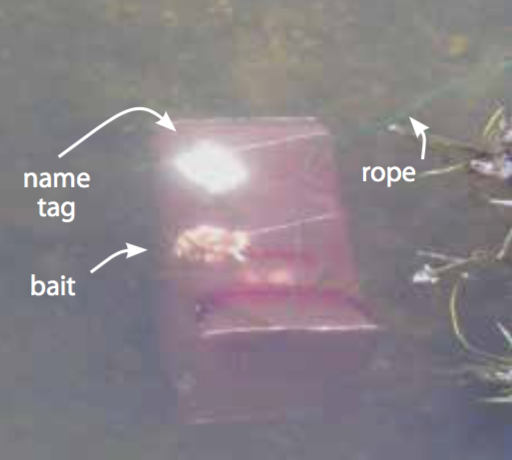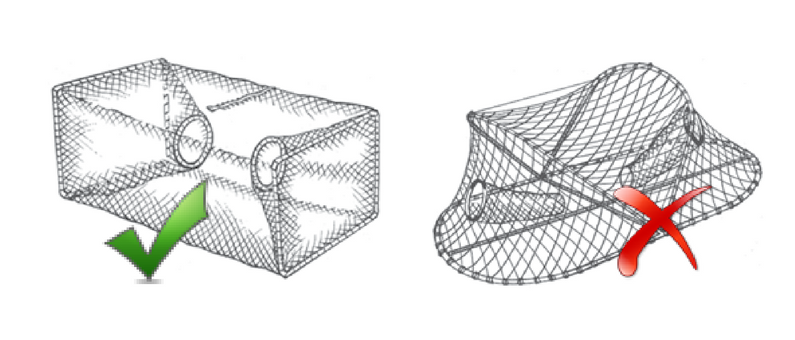Header: Crimson-spotted Rainbow Fish. Photo by Gunther Schmida.
In the October 2014 newsletter, I mentioned that I would share some tips on surveying freshwater fish. These tips are for landholders who want to identify freshwater fish on their own properties as a hobby. Please note that if you wish to survey freshwater fish as part of a structured scientific study, including collecting ecological data or publicly presenting data, two Queensland Government permits (animal ethics and fisheries) are required.
These tips come from fish geneticist, Leo Lee, who has been playing with fish since he was three years old. Ithaca Creek in western Brisbane has been his “home” creek since that age, and he fondly remembers catching huge numbers of Crimson-spotted Rainbow fish there. These fish used to be called Giant Rainbow fish and Leo caught individuals that were 20 cm in length. These days, you are lucky to catch one that is 8 cm in length. As with all native freshwater fish, Crimson-spotted Rainbow fish used to be abundant and widespread, whereas now they are found in low numbers in a few isolated locations.
Please follow Leo’s main advice: “Don’t translocate (move) fish”. Moving fish from one creek to another can reduce genetic diversity and introduce new diseases into healthy populations. For the same reasons, never release captive fish into creeks.
To find freshwater fish on your property you will need three things: a trap, a large bucket and some strong rope. For less than $10, you can pick up a box trap (also called a yabby or funnel trap) from most camping stores. These traps have two funnels that lead into a main chamber, preventing fish from easily swimming out. Remember to never use ‘Opera Style’ traps as their large entrance holes can trap and kill platypus.
Firstly, you need to find a suitable site to survey. Box traps are most effective in shallow water, so you want a site with a gradual sloping bank and water about half a metre deep.
 A box trap set in a shallow creek. Note the bait in the centre (with some fish swimming around), a name tag of the trap owner that is required by law, and the rope leading to the creek bank. Photo by Leo Lee.
A box trap set in a shallow creek. Note the bait in the centre (with some fish swimming around), a name tag of the trap owner that is required by law, and the rope leading to the creek bank. Photo by Leo Lee.
Now attached a long rope to both the trap and large bucket. This allows you to retrieve these items from the creek without getting your feet wet. Then, fill only one-third of the large bucket with creek water (if filled fully, fish will jump out) and leave it on the bank edge.
Now we need to bait the trap. Leo recommends using one quarter of a slice of fruit bread, with vegemite, as bait. Naively, I thought that most freshwater fish were carnivores. Leo corrected me by saying that Australian freshwater fish have evolved to cope with the highest variation in water flows worldwide, meaning that they have learned to survive in tiny pools of water during drought, to raging torrents during flood. Thus, they will eat almost anything – invertebrates and vegetation.
Once baited, place the trap into the creek remembering that it will work best in shallow water that just covers the trap. Don’t walk into the creek as this will disturb the fish. Check the trap (remove it from the creek) every five minutes. In a healthy creek in the Upper Brisbane catchment, Leo has caught 200 fish in one trap after five minutes. If you leave the trap in for too long (over an hour), trapped fish can die.
To remove the trap, pull the trap out (using the rope) reasonably quickly so that the fish are pushed to the bottom of the net. Don’t yank it out and send the fish flying, but just quickly remove it in one motion. Once caught, transfer fish from the trap to the large bucket filled with creek water so you can easily see and identify the fish.
 A box or funnel trap (top image) must be no longer than 70 cm or no more than 50 cm in width or height. The trap entrance must be made of rigid material. If the trap does not have a mesh made of rigid material, the size of the mesh must be no more than 25 mm. All freshwater traps must have a tag on the trap showing the owner’s surname and address.
A box or funnel trap (top image) must be no longer than 70 cm or no more than 50 cm in width or height. The trap entrance must be made of rigid material. If the trap does not have a mesh made of rigid material, the size of the mesh must be no more than 25 mm. All freshwater traps must have a tag on the trap showing the owner’s surname and address.
Do not use ‘Opera Style’ traps (lower image) as these can trap and kill platypus.
Images from Department of Agriculture and Fisheries www.da .qld.gov.au
Put all native fish back into the same creek in the same location where you caught them. It can be strange to think about fish having ‘local provenance’, but they do. We often hear this term in regards to plants, but animals also have local provenance. Fish are confined to their creeks and cannot move between catchments unless there is an extreme weather or climatic event. This isolation as well as mutations give rise to genetic variation. Therefore, there may be important genetic differences within one fish species along the same creek. This genetic diversity keeps the whole population healthy.
If you catch any pest fish in your trap, you are required to immediately and humanely kill them according to the Queensland Fisheries Regulation 2008. This applies to both declared noxious fish species such as tilapia, carp and gambusia (mosquitofish) and also non-indigenous fish such as guppies and swordtails. Remove pest fish away from the creek and dispose of them in land fill or bury them. Please note that it is illegal to keep or use as bait noxious fish.
According to Leo, the best time to survey for native freshwater fish is late October to early November. During this period water temperatures are warming and hungry fish are emerging from their winter dormancy. They will readily be attracted to bait.
There is lots of information online about native and pest fish including the Department of Agriculture and Fisheries at www. daff .qld.gov.au
Article by Deborah Metters Land for Wildlife Regional Coordinator SEQ Catchments

I know this is an old article but I noticed you mentioned the size variations of the crimson spot rainbow and not seeing large ones anymore. Come to the nogoa river in emerald I’m an amateur hobbyist who catches the pest mosquito fish to feed to my axolotl and sometimes as by catch I get thes rainbows most around 2-5cm but out deep you can see larger ones flashing just below the surface when Ur wading around under the bridges. I have kept one and grown it out to 10cm so far just out of curiosity and I’ve been trying to ID it for 12months(till I found this article). I have a second that was a fry in with the mosquito fish(I misidentified as a guppy fry) which grew out to be another rainbow. They are now prolifically dumping eggs all over my Axolotl tank(they live peacefully with my Axi, so I jave started collecting and trying start a species tank with the fry.If anyone is interested I genetic testing of the local variant or locations for further research on them I can gladly help out as there isn’t much I depth info just basic ‘rainbow’ broadbanner type info for them in aquaria…
So far I was under the understanding that they require warm water and a few other things in order to get them to breed but I have a low light cold water tank and as I said dumping eggs weekly only on basic flake,the occasion fly or mosquito gets thrown in(or tiny shrimp). Any advice on care or further reading on the species would be much appreciated.